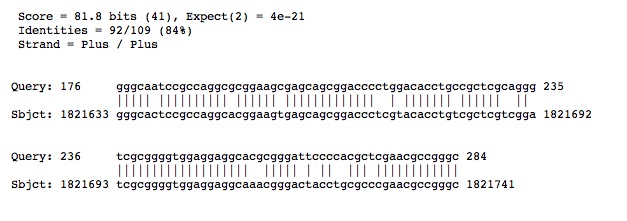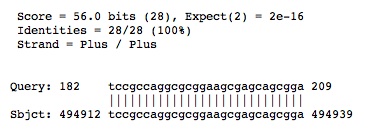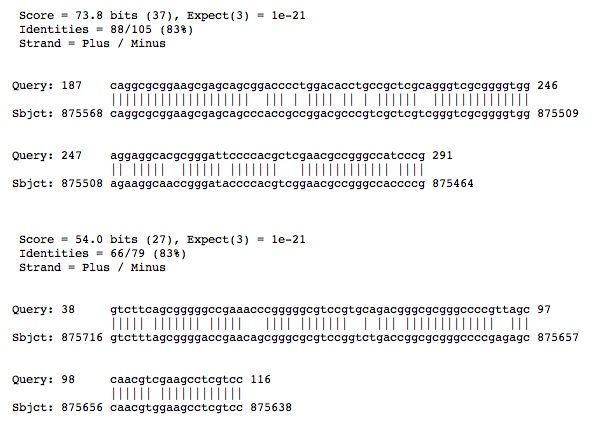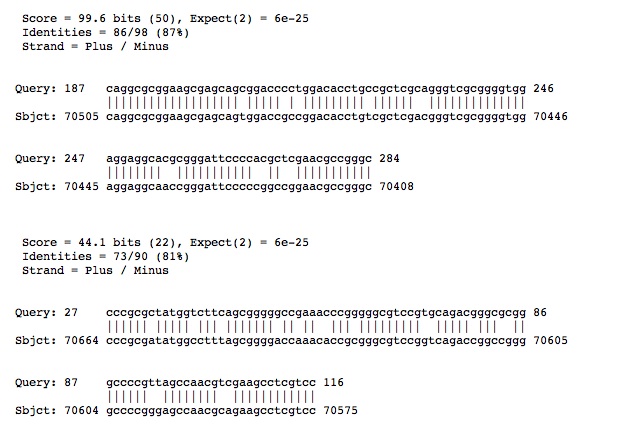Missing RNA genes? 2009
In looking for other RNA genes we did the following. . .
1). We looked at the two "other RNA" genes from last year's species (Halorhabdus utahensis AX-2, DSM 12940) and compared those sequences to our species entire genome using Halomicrobium mukohataei genome portal
Results are as follows. . .
For "other RNA" gene 2500590731, named SRP_euk_arch, in the Halorhabdus utahensis AX-2, DSM 12940 genmone (820149..820441 (-)(293bp)):
Genome Portal Results

For "other RNA" gene 2500590732, named RNaseP_arch, in the Halorhabdus utahensis AX-2, DSM 12940 genmone (2878153..2878553 (-)(401bp)):
Genome Portal Results

2). We also looked to ensure that all 20 amino acids had an associated tRNA gene encoded and found that all 20 amino acids were represented (although at varying frequencies).
3). We looked at the other halophiles (Halogeometricum borinquense PR3, DSM 1155 and Haliangium ochraceum SMP-2, DSM 14365) listed on the Adopt a Genome JGI site and none of them, besides the species annotated last year, had "other RNA" genes.
4). In further research we looked at other halophile genomes and used the blast from Genome Portal for all halophiles listed on the homepage. The blast for "other RNA" genes against each of the other species are as seen below. . .
A). SRP Gene
Halogeometricum borinquense
Halorhodospira halophila No hits found.
Halorubrum lacusprofundi
Haloterrigena turkmenica
Halothermothrix orenii No hits found.
Halothiobacillus neapolitanus No hits found.
B). RNase-P Gene
Halogeometricum borinquense
 S = 109 bits (55)
E = 1e-37
Identities = 94/107 (87%)
Strand = Plus / Plus
S = 109 bits (55)
E = 1e-37
Identities = 94/107 (87%)
Strand = Plus / Plus
Halorhodospira halophila No hits found.
Halorubrum lacusprofundiS = 79.8 bits (40) E = 4e-31 Identities = 49/52 (94%) Strand = Plus / Minus
Haloterrigena turkmenicaS = 83.8 bits (42) E = 5e-26 Identities = 72/82 (87%) Strand = Plus / Plus
Halothermothrix orenii No hits found.
Halothiobacillus neapolitanus No hits found.
5). We also examined Haloferax volcanii, a species of halophile that was found through-out our blasts results while attempting to confirm annotation of tRNA genes. The genome for this halophile has previously been annotated by UCSC and researchers have not yet identified the existence of "other RNA" genes.
6). Based on literature searches, we have found some new information on RNaseP.
Life without RNase P One study featured in Nature describes an archaea species that has no RNasP. The paper describes the mechanisms this species has adopted in order to overcome this barrier. In the future, if we cannot find enough information to adequately describe this gene in our species, we can use this paper to determine if perhaps our species has other mechanisms in place to properly cleave RNA.
In search of RNase P RNA from microbial genomes Another study has some promising information for the identification of RNaseP. This study said that they established highly conserved sequences in this gene in both bacteria and archaea. The authors also said they created a PERL script to retreive sequences that matched these conserved sequences and the results were validated using RNAmotif. I do not know how to use PERL or where to find this group's PERL script. Nevertheless, if we can obtain access to these resources, it could validate the sequence we have discovered as the RNaseP gene for our species.
In the future we would like to. . .
1). Compare our species to very closely related species that have been annotated for "other RNA genes"
2). Determine what "other RNA" genes we should be looking for in archae specifically.